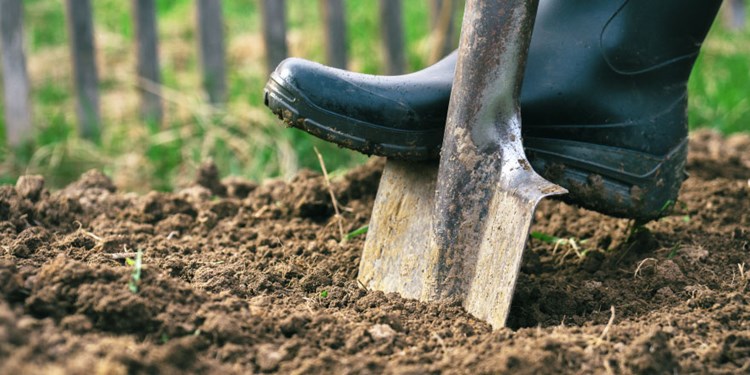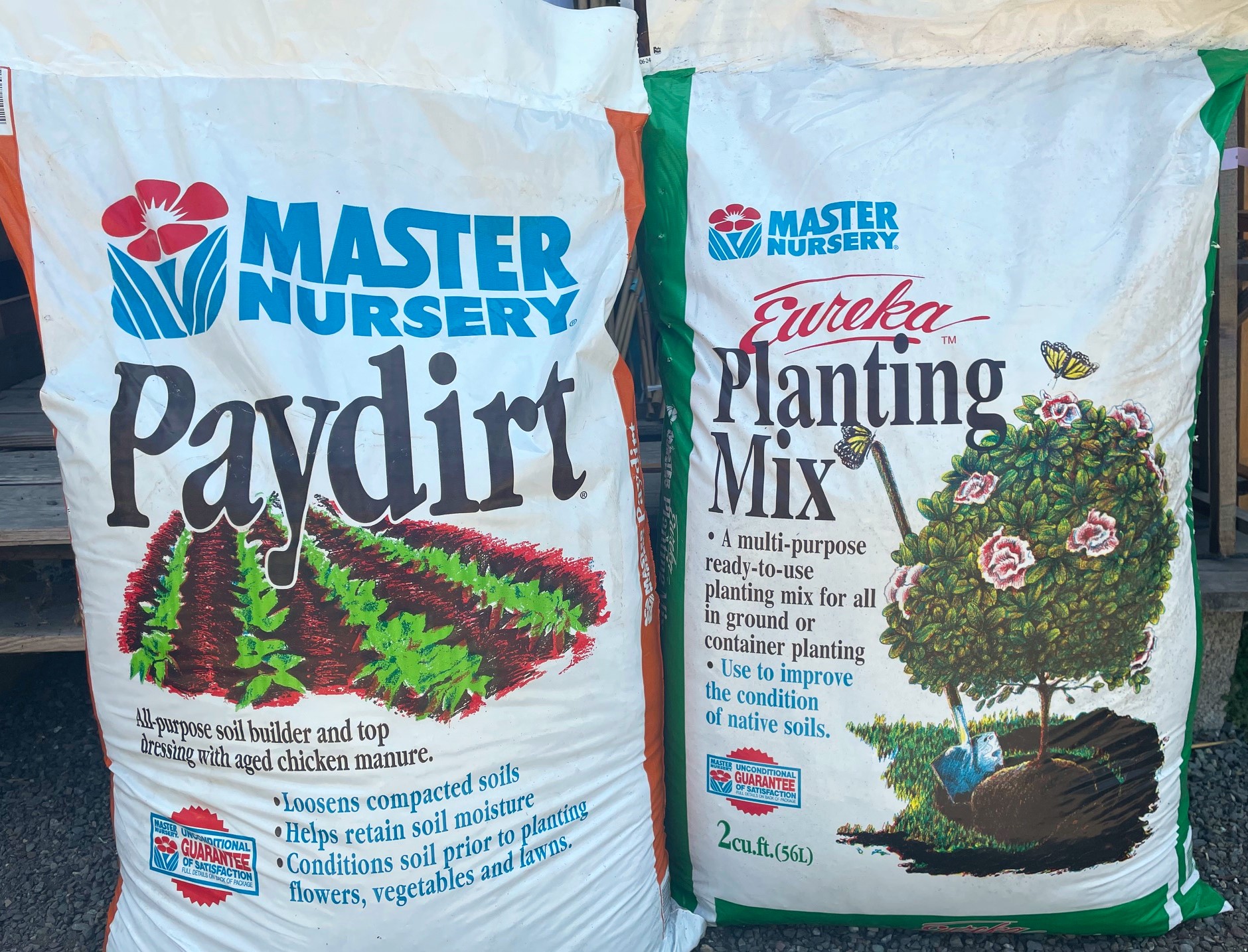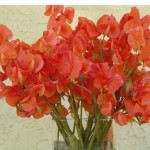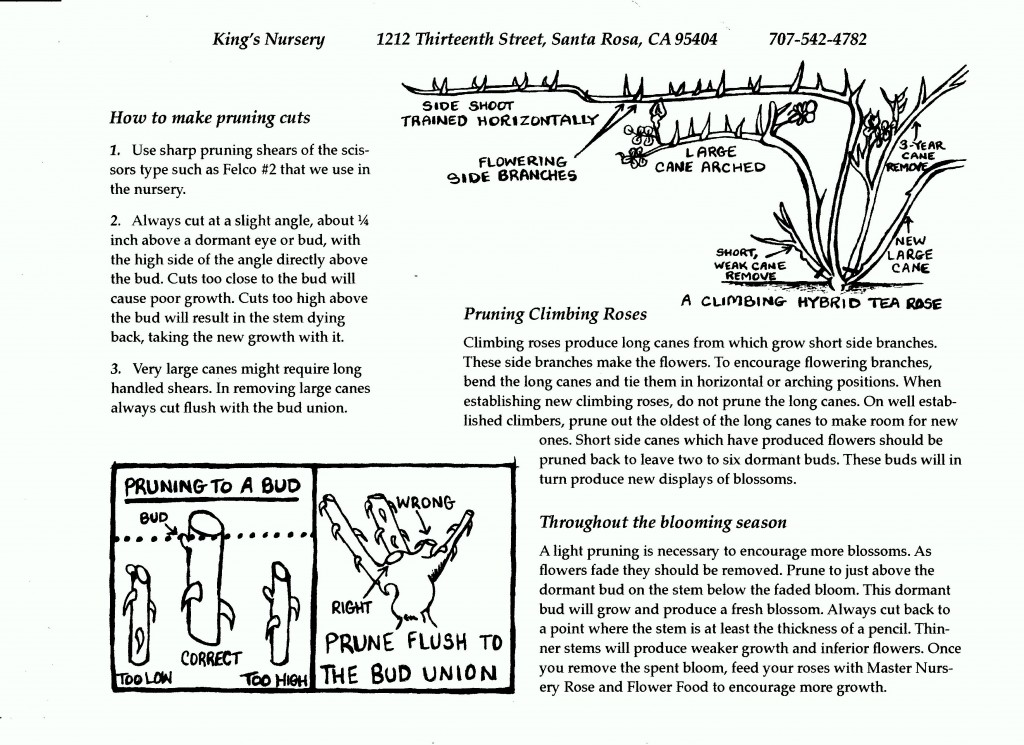by King's Nursery | Feb 21, 2010 | Custom Planting, Hanging Baskets, How-to Info
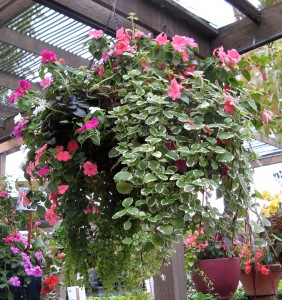
Living Bouquet Basket for shade
King’s has specialized in hanging baskets for many years. None are more fun to make or grow than the mixed baskets of flowers we call Living Bouquets. Planted and maintained correctly, they will give you an entire season of colorful blossoms. Making your own basket can be lots of fun, although quite a challenge for us to explain. The following is a guideline to get you started. If you have questions or need advice, drop by the Nursery; we’ll be happy to help.
What you will need:
A hanging basket, 12” in diameter or larger
A swivel hanger for the basket
Sphagum moss to line the basket
A bucket with water
Quality potting soil – we use MasterNursery “Professional Potting Soil”
Fertilizer – we use a combination of Master Start and Osmocote
A soil polymer such as SoilMoist (optional)
A selection of flowers, veggies, herbs, or greens
We need to grasp the concept that the moss is merely a liner around the basket used to hold in the soil. The moss is easy to work with when wet. That’s why we have the bucket. Submerge the moss in the bucket full of water. With the basket in front of you, take the moist pieces of moss out of the bucket. Smash the piece flat like a hamburger patty. Place the flattened moss in the bottom of the basket. Continue lining the bottom and sides of the basket, slightly overlapping flattened pieces of moss. Continue up the sides until you are about 1/3 of the way up. Remember the moss is merely a liner to hold the soil. There is no reason to completely fill the basket with moss. What you should now have resembles a bird’s nest in the bottom of the basket.
Into the nest, or depression, you want to pack in your potting soil/fertilizer mixture. Bringing it right up to the top of the moss. Your soil mix should consist of 1/3 cubic foot Potting Soil, 1/3 cup Osmocote, 2 Tbsp Master Start, and 1 to 2 Tbsp SoilMoist.
Now come the first of your plants. For a 12” basket, we only want to put 4 plants on the bottom layer. From the inside out – that means you are threading the foliage through the wire from the inside – place one plant at 12 o’clock, one plant at 3 o’clock, one plant and 6 o’clock, and one plant at 9 o’clock. Make sure the foliage extends outside the basket and the roots are inside, in good contact with the soil.
Smash down more moss and line the basket another 1/3 of the way up. Add more soil mixture to the top of the moss, packing down firmly, thus covering the roots of the plants already in the basket. On this layer put 6 plants, bracketing the 4 on the bottom row. When you have placed them to your satisfaction, continue lining the basket with moss all the way to the top, and slightly over the edge of the basket. Fill the basket to about 1” from the top with soil and pack down firmly. Plant 5 or more flowers in the top of the basket; 4 equaly spaced near the edges and one in the middle.
Carefully attach the wire hanger and water thoroughly but gently. You are now ready to hang the basket. Choose a location that is compatible with the plants you have chosen. As the basket matures, it will need more and more water. Daily during the summer is not too much. Water slowly and thoroughly. One gallon applied slowly is more efficient than three gallons squirted on. From time to time we feed with Maxsea, a superior liquid plant food.
When the season ends for your basket, you may salvage the basket, hanger, and some of the better moss. We always start over with new soil, fresh moss, and new plants. This produces a superior basket. That’s the entire procedure. Try not to skip any of the steps or materials as each is very important to the overall health and beauty od the basket. Remember, if you are confused, call or drop by the Nursery and ask for help. All of us at King’s have made many, many baskets and want yours to turn out great!
Finally, here are some guidelines for plant choices for your basket. Remember to put compatible plants together. All the plants in each basket should have similar requirements as to sun, water, etc.
Spring and Summer plants for the sun:
Lobelia
Petunia
Alyssum
Verbena
Marigold
Phlox
Zinnia
Golden Fleece
Bidens
Million Bells
Sanvitalia
Spring and Summer plants for the shade or part sun:
Impatiens
Lobelia
Schizanthus
Nemesia
Begonia
Mimulus
Bacopa
Fuchsia
Fall and Winter plants for sun:
Pansy
Viola
Winter Daisy
Dwarf Snapdragon
Toadflax
maybe Lobelia and Alyssum
Fall and Winter plants for shade and part sun:
English Primrose
Fairy Primrose
Cyclamen
Primula obconica
Ivy
maybe Lobelia, Nemesia, and Schizanthus
Let your imagination run wild. If you discover some new combinations that work for you, we’d love to hear about it…and see pictures!
by King's Nursery | Feb 21, 2010 | How-to Info
King’s guide to deer resistant plants. Deer can be a frustrating nuisance, but there is some relief! The following is a sample of shrubs and flowers that deer generally avoid and do well in our area. We do like to recommend that a repellent such as Liquid Fence be used when plants are first planted to protect young foliage. The list is arranged by botanical name followed by common name.
Annuals:
Ageratum houstonianum – Floss Flower
Alcea species – Hollyhock
Celosia cristata – Cockscomb
Centaurea cyanus – Bachelor’s Button
Cleome spinosa – Spider Flower
Coreopsis species – Coreopsis
Cosmos species – Cosmos
Dyssodia tenuiloba – Dahlberg Daisy
Eschscholzia californica – California Poppy
Gaillardia species – Gaillardia
Gypsophila – Baby’s Breath
Helianthus species – Sunflower
Impatients balsamina – Balsam
Impatiens wallerana – Busy Lizzie
Ipomoea species – Morning Glory
Limonium sinuatum – Statice
Lobelia erinus – Lobelia
Lobularia maritima – Sweet Alyssum
Myostis sylvatica – Forget-Me-Not
Nigella damascena – Love-in-the-Mist
Papaver rhoeas – Shirley Poppy
Portulaca grandiflora – Rose Moss
Salvia species – Sage
Sanvitalia procumbens – Creeping Zinnia
Scabiosa atropurpurea – Pincushion Flower
Senecio cineraria – Dusty Miller
Tithonia rotundiflora – Mexican Sunflower
Perennials:
Achillea species – Yarrow
Alcea rosea – Hollyhock
Aloe species – Aloe
Alstromeria – Peruvian Lily
Anenome japonica
Aquilegia – Columbine
Armeria maritima – Common Thrift
Artemesia species – Wormwood
Artichoke
Aster species – Perennial Asters
Astilbe – Meadow Sweet
Aubrieta deltoidea – Common Aubrieta
Aurinia saxatilis – Perennial Alyssum
Bellis perennis – English Daisy
Beloperone guttata – Shrimp Plant
Bergenia – Saxifraga
Brachycome iberdifolia – Swan River Daisy
Centaurea cineraria – Dusty Miller
Centranthus ruber – Jupiter’s Beard
Chrysanthemum frutescens – Marguerite
Chrysanthemum partenuim – Feverfew
Coreopsis species
Dicentra species – Bleeding Heart
Digitalis species – Foxglove
Echium fastuosum – Pride of Madeira
Erigeron glaucus – Santa Barbara Daisy
Eriogonom species – Buckwheat
Erysimum linifolium – Bowle’s Mauve
Euryops species
Felicia amelloides – Blue Marguerite
Galium odoratum – Sweet Woodruff
Geranium – Cranesbill
Gerbera jamesonii – Transvaal Daisy
Gypsophila – Baby’s Breath
Helichrysum species – Strawflower
Helleborus niger – Christmas Rose
Hemerocallis – Daylily
Heuchera sanguinea – Coral Bells
Iris species
Kniphofia uvaria – Red Hot Poker
Lantana montevidensis – Trailing Lantana
Lavandula species – Lavener
Leonotis leonurus – Lion’s Tail
Limonium – Sea Lavender
Liriope muscari – Lily Turf
Lobelia cardinalis – Cardinal Flower
Lupinus species – Lupine
Lychnis coronaria – Crown Pink
Mimulus – Monkey Flower
Mirabilis – Four O’Clock
Monarda species – Bee Balm
Nepeta faassenii – Catmint
Nierembergia species – Cupflower
Oenothera species – Evening Primrose
Origanum dictamnus – Crete Dittany
Papaver orientale – Oriental Poppy
Penstemon – Beard Tongue
Phlox subulata – Moss Pink
Rudbeckia hirta – Gloriosa Daisy
Ruta graveolens – Common Rue
Salvia species – Sage, Salvia
Santolina chamaecyparissus- Lavender Cotton
Scabiosa columbaria – Pincushion Flower
Silene acaulis – Cushion Pink
Stachys byzantina – Lamb’s Ear
Tagetes lemmonii – Bush Marigold
Tropaeolum – Nasturtium
Tulbaghia violacae – Society Garlic
Verbena peruviana – Peruvian Verbena
Viola odorata – Sweet Violet
Zantendeschia – Calla Lily
Bulbs:
Alstromeria – Peruvian Lily
Amaryllis belladonna – Naked Lady
Begonia – Tuberous Begonia
Canna
Crocosmia – Montbretia
Crocus
Cyclamen
Cymbidium – Terrestrial orchids
Cypripedium californicum – Lady Slipper
Dahlia imperialis – Tree Dahlia
Freesia
Fritillaria imperialis – Crown Imperial
Galanthus elwesii – Giant Snowdrop
Ixia
Muscari – Grape Hyacinth
Narcissus – Daffodil
Scillia – Blue Bells
Watsonia – Bugle Lily
Zantedeschia – Calla Lily
Grasses (and grass-like plants):
Acorus variegatus – Japanese Sweet Flag
Alopecurus pretensis “Aureovariegatus” – Yellow Meadow Foxtail
Arundinaria viridistriata – Dwarf Running Bamboo
Arundo donax – Reed Grass
Briza maxima/media – Quacking Grass
Calamagrostis – Feather Reed Grass
Carex – Sedge Grass
Deschampsia caespitosa – Tufted Hair Grass
Dietes – Fortnight Lily
Festuca – Fescue
Hakonechloa – Golden
Imperata – Japanese Blood Grass
Juncus – Common Rush
Miscanthus – Feather Grass
Molinia – Purple Moor Grass
Pennisetum – Fountain Grass
Phalaris – Ribbon Grass
Phormium – New Zealand Flax
Stipa gigantea – Feather Grass
Vines and Groundcover:
Ajuga reptans – Carpet Bugle
Anthemis nobilis – Chamomile
Bougainvillea species
Campsis species – Trumpet Creeper
Carpobrotus edulis – Ice Plant
Ceratostigma plumbaginoides – Dwarf Plumbago
Chamaemelum nobile – Chamomile
Clematis armandii – Evergreen Clematis
Coprosma kirkii – Creepingn Coprosma
Erodium chamaedryoides – Crane’s Bill
Ficus pumilla – Creeping Fig
Gazania species
Gelsemium sempervirens – Carolina Jasmine
Hedera helix – English Ivy
Herniaria glabra – Green Carpet
Irish moss
Isotoma – Blue Star Creeper
Jasminium species – Jasmine
Juniper species – Juniper
Lithidora diffusa
Lotus berthelotii – Parrot’s Beak
Mint species
Myoporum parvifolium – Creeping Myoporum
Muehlenbeckia – Mattress Vine
Osteospermum fruticosum – Trailing African Daisy
Pachysandra terminalis – Japanese Spurge
Polygonum – Knotweed
Scaevola – Mauve Clusters
Solanum jasminoides – Potato Vine
Stachys byzantina – Lamb’s Ears
Thumbergia alata – Black-Eyed Susan Vine
Thymus species
Vinca species – Periwinkle
Viola odorata – Sweet Violet
Wisteria species – Wisteria
Zauschneria californica – California Fuschia
Trees:
Acer palmatum – Japanese Maples
Aesculus calofirnica – California Buckeye
Albeisia – Silk Tree
Arbutus – Strawberry Tree
Catalpa species
Cinnamomum camphora – Camphor Tree
Conifers: cedar, fir, pine, redwood, spruce
Cotinus coggyria – Smoke Tree
Crataegus species – Ash
Diospyros – Persimmon
Eucalyptus species
Ficus carica – Fruiting Fig
Fraxinus species – Ash
Ginko biloba – Maidenhair Tree
Lagerstroma indica – Crepe Myrtle
Laurus nobilis – Grecian Laurel
Liquidamber styraciflua – Sweet Gum
Magnolia species – Magnolia
Maytenus boaria – Mayten Tree
Olea europaea – Olive
Pistachia chinensis – Chinese Pistache
Podocarpus granatum – Yew Pine
Punica granatum – Pomegranate
Quercus species – Oak
Quince – Fruiting Quince
Rhus species – Sumac
Scinus species – Pepper Tree
Sequoia sempervirens – Coast Redwood
Thuja plicata – Western Red Cedar
Umbellularia californica – California Bay
Bushes and shrubs:
All Ferns
Agapanthus species – Lily of the Nile
Alyogyne huegelii – Blue Hibiscus
Arctostaphylos – Manzanita
Bamboo species
Berberis species – Barberry
Brugmansia – Angel’s Trumpet
Buddleia – Butterfly Bush
Buxus species – Boxwood
Callistemon species – Bottlebrush
Ceanothus – Wild Lilac
Chaenomeles species – Flowering Quince
Choisya ternata – Mexican Mock Orange
Cistus species – Rockrose
Clivia miniata – Kaffir Lily
Coleonema pulchrum – Pink Breath of Heaven
Convovulus cneorum – Bush Morning Glory
Coprosma kirkii – Dwarf Mirror Plant
Cordyline autralis – Dracena Palm
Corokia cotoneaster – Twisted Cotoneaster
Correa pulchella – Australian Fuchsia
Cotoneaster lacteus – Red Clusterberry
Crassula argentea – Jade Plant
Cyperus species – Papyrus
Daphne species – daphne
Dendromecon harfordii – Island Bush Poppy
Dodonaea viscosa – Hop Bush
Dracena species – Dragon Palm
Echium fastuosum – Pride of Madeira
Echium wildpretii – Tower of Jewels
Elaeagnus species – Silverberry
Erica – Heath
Eriogonum arboresscens – Wild Buckwheat
Euphorbia species – Spurge
Fatsia japonica – Japanese Aralia
Feijoa sellowiana – Pineapple Guava
Ferns – all types
Forsythia species – Forsythia
Fremontodendron – Flannel Bush
Garrya elliptica – coastal Silktassle
Gaultheria shallon – Salal
Geranium – Cranesbill
Geranium – scented varieties
Grevellia species – Grevellia
Hakea sauveolens – Sweet hakea
Halimium lasianthum – Sunrose
Hebe buxifolia – Boxleaf Hebe
Helianthemim nummularium – Sun Rose
Heteromeles arbutifolia – Toyon
Hypericum calycinum – St. John’s Wort
Ilex species – Holly
Impatiens oliveri – Snapweed, Poor Man’s Rhododendron
Iris species – Iris
Juniperus species – Juniper
Kniphofia uvaria – Red Hot Poker
Kolkwitzia amabilis – Beauty Bush
Lagerstoemia indica – Crepe Myrtle
Lavandula species – Lavender
Leptospermum species – Tea Tree
Loropetalum chinense – Chinesse Witch Hazel
Lupinus arboreus – Lupine
Mahonia species – Oregon Grape
Melaleuca species – Melaleuca
Melianthus major – Honey Bush
Metrosideros excelsus – New Zealand Christmas Tree
Moraea iridiodes – African Iris
Myoporum species – Myoporum
Myrica californica – Pacific Wax Myrtle
Myrtus communis – Common Myrtle
Nandina domestica – Heavenly Bamboo
Nerium oleander – Oleander
Philadelphus coronarius – Sweet Mock Orange
Philodendron selloum – Bigleaf Philodendron
Phlomis fruiticosa – Jerusalem Sage
Phormium tenax – New Zealand Flax
Pieris species – Pieris
Plumbago auriculata – Cpae Plumbago
Poinciana gilliesii – Bird of Paradise Bush
Potentilla fruiticosa – Bush Cinquefoil
Prostanthera rotundifolia – Mint Bush
Punica granatum – Pomegranate
Quercus – Oak
Rhamnus californica – California Coffeeberry
Rhododendron species – Rhododendron (not Azaleas)
Rhus species – Sumac
Ribes species – Currant, Gooseberry
Romneya coulteri – Matilija Poppy
Rosmarinus officinalis – Rosemary
Ruhus vitifolius – Blackberry
Salvia secies – Salvia, Sage
Sambucus caerulea – Blue Elderberry
Sarcococca species – Sarcococca, Sweet Box
Sollya heterophylla – Australian Bluebell
Strelitzia species – Bird of Paradise
Syringa species – Common Lilac
Syzygium paniculatum – Brush Cherry
Tamaarix species – Tamarisk
Tellima grandiflora – Fringe Cup
Tetrapanax papyruferus – Rice Paper Plant
Teucrium fruticans – Bush Germander
Thuya / Thuja scpecies – Arborvitae
Westringia rosmariniformis – Westringa
Yucca glauca – Small Soapweed
